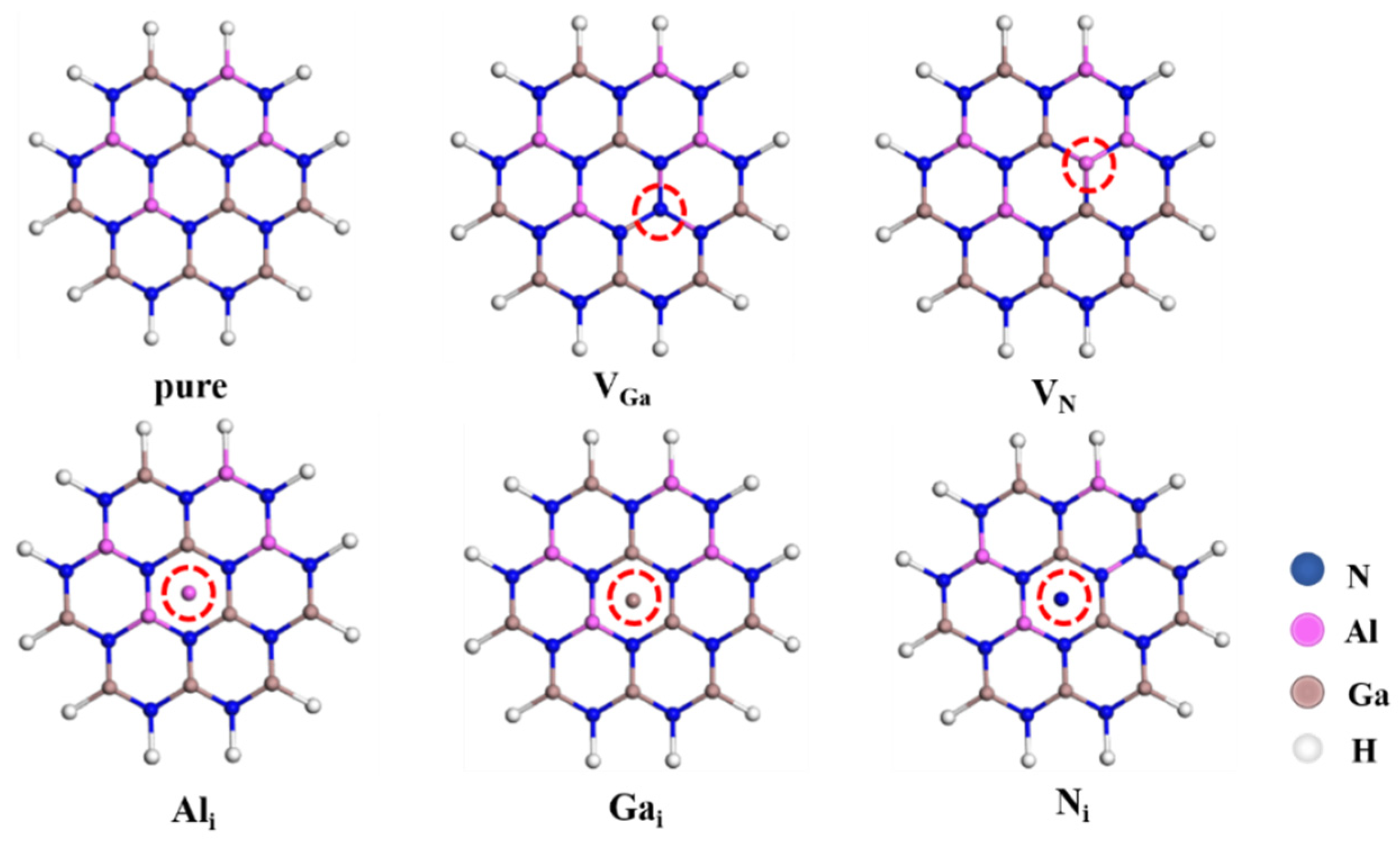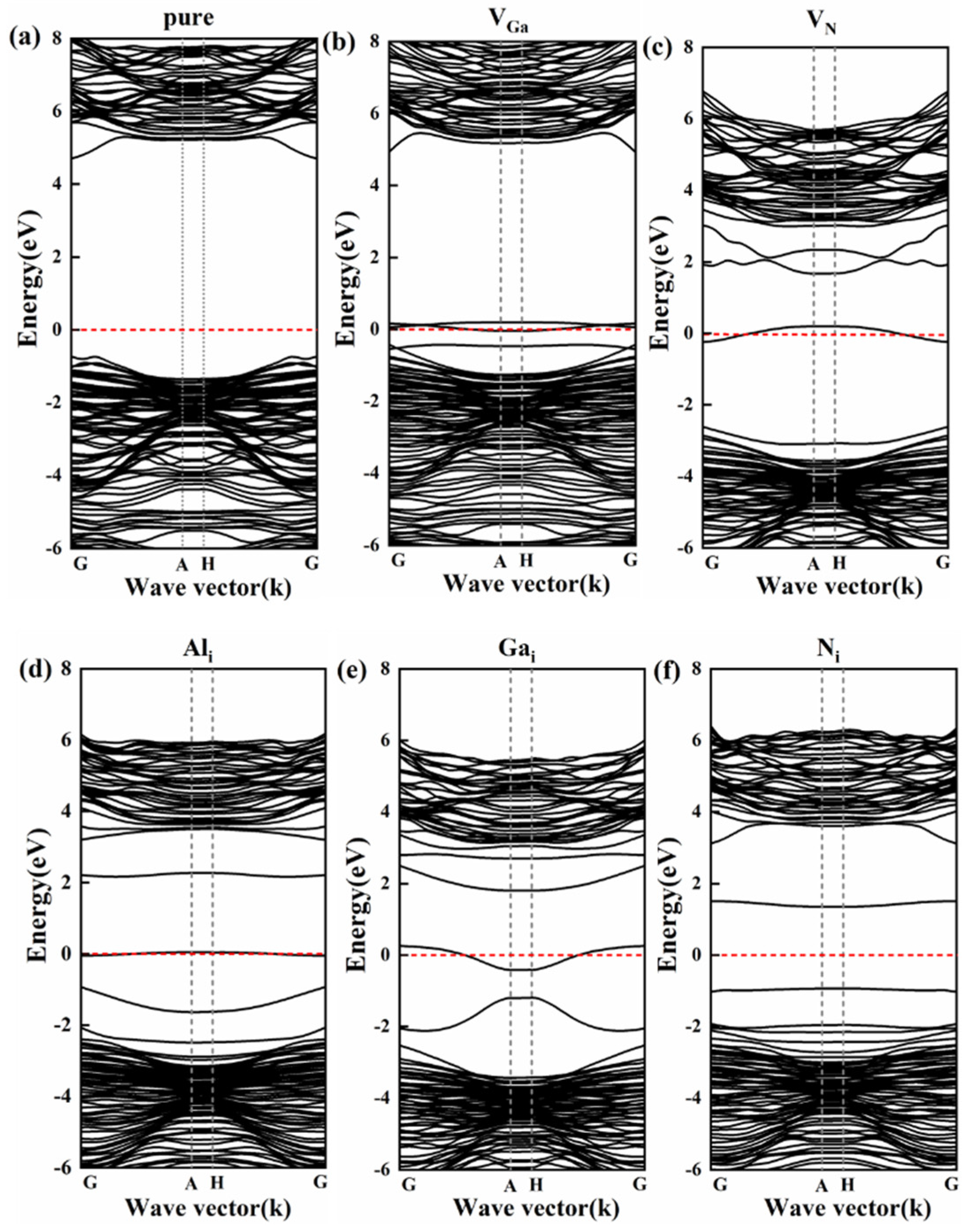Effects of Different Point Defects on the Electronic Properties of III–V Al0.5Ga0.5N Photocathode Nanowires
Abstract
1. Introduction
2. Calculation Models and Method
3. Results and Discussion
4. Conclusions
Author Contributions
Funding
Institutional Review Board Statement
Informed Consent Statement
Data Availability Statement
Acknowledgments
Conflicts of Interest
References
- Mizuno, S. Acoustic Phonon Modes and Phononic Bandgaps in GaN/AlN Nanowire Superlattices. Nanoscale Res. Lett. 2012, 7, 479. [Google Scholar] [CrossRef] [PubMed]
- Jayaprakash, R.; Ajagunna, D.; Germanis, S.; Androulidaki, M.; Tsagaraki, K.; Georgakilas, A.; Pelekanos, N.T. Extraction of Absorption Coefficients from as-Grown GaN Nanowires on Opaque Substrates Using All-Optical Method. Opt. Express 2014, 22, 19555–19566. [Google Scholar] [CrossRef]
- Nam, C.-Y.; Jaroenapibal, P.; Tham, D.; Luzzi, D.E.; Evoy, S.; Fischer, J.E. Diameter-Dependent Electromechanical Properties of GaN Nanowires. Nano Lett. 2006, 6, 153–158. [Google Scholar] [CrossRef] [PubMed]
- Kim, S.S.; Park, J.Y.; Choi, S.W.; Kim, H.S.; Na, H.G.; Yang, J.C.; Lee, C.; Kim, H.W. Room Temperature Sensing Properties of Networked GaN Nanowire Sensors to Hydrogen Enhanced by the Ga2Pd5 Nanodot Functionalization. Int. J. Hydrog. Energy 2011, 36, 2313–2319. [Google Scholar] [CrossRef]
- Sergent, S.; Damilano, B.; Vézian, S.; Chenot, S.; Tsuchizawa, T.; Notomi, M. Lasing Up to 380 K in a Sublimated GaN Nanowire. Appl. Phys. Lett. 2020, 116, 223101. [Google Scholar] [CrossRef]
- Routray, S.; Lenka, T. Performance Analysis of Nanodisk and Core/Shell/Shell-Nanowire Type III-Nitride Heterojunction Solar Cell for Efficient Energy Harvesting. Superlattices Microstruct. 2017, 111, 776–782. [Google Scholar] [CrossRef]
- Mao, S.; Liu, Y.; Li, P.; Meng, X. Fabrication and Comparative Study of Vertically Grown and Horizontally-Dispersed Fully Nanowire-Based Photodetectors. Appl. Surf. Sci. 2015, 359, 496–499. [Google Scholar] [CrossRef]
- Memisevic, E.; Hellenbrand, M.; Lind, E.; Persson, A.R.; Sant, S.; Schenk, A.; Svensson, J.; Wallenberg, R.; Wernersson, L.-E. Individual Defects in InAs/InGaAsSb/GaSb Nanowire Tunnel Field-Effect Transistors Operating below 60 mV/Decade. Nano Lett. 2017, 17, 4373–4380. [Google Scholar] [CrossRef]
- Roy, A.; Mead, J.; Wang, S.; Huang, H. Effects of Surface Defects on the Mechanical Properties of ZnO Nanowires. Sci. Rep. 2017, 7, 9547. [Google Scholar] [CrossRef]
- Wang, J.; Wang, J.G.; Qin, X.; Wang, Y.; You, Z.; Liu, H.; Shao, M. Superfine MnO2 Nanowires with Rich Defects toward Boosted Zinc Ion Storage Performance. ACS Appl. Mater. Interfaces 2020, 12, 34487–35766. [Google Scholar] [CrossRef]
- Heo, J.; Cho, K.-H.; Jain, P.K. Motion of Defects in Ion-Conducting Nanowires. Nano Lett. 2020, 21, 556–561. [Google Scholar] [CrossRef] [PubMed]
- Dai, S.; Zhao, J.; He, M.-R.; Wang, X.; Wan, J.; Shan, Z.; Zhu, J. Elastic Properties of GaN Nanowires: Revealing the Influence of Planar Defects on Young’s Modulus at Nanoscale. Nano Lett. 2014, 15, 8–15. [Google Scholar] [CrossRef] [PubMed]
- Hemesath, E.R.; Schreiber, D.K.; Gulsoy, E.B.; Kisielowski, C.F.; Petford-Long, A.K.; Voorhees, P.W.; Lauhon, L.J. Catalyst Incorporation at Defects during Nanowire Growth. Nano Lett. 2011, 12, 167–171. [Google Scholar] [CrossRef] [PubMed]
- Biswas, S.; Barth, S.; Holmes, J.D. Inducing Imperfections in Germanium Nanowires. Nano Res. 2017, 10, 1510–1523. [Google Scholar] [CrossRef]
- Chen, W.; Yu, L.; Misra, S.; Fan, Z.; Pareige, P.; Patriarche, G.; Bouchoule, S. Incorporation and Redistribution of Impurities into Silicon Nanowires during Metal-Particle-Assisted Growth. Nat. Commun. 2014, 5, 4134. [Google Scholar] [CrossRef]
- Alvarez, A.D.; Peric, N.; Vergel, N.A.F.; Nys, J.-P.; Berthe, M.; Patriarche, G.; Harmand, J.-C.; Caroff, P.; Plissard, S.; Ebert, P.; et al. Importance of Point Defect Reactions for the Atomic-Scale Roughness of III–V Nanowire Sidewalls. Nanotechnology 2019, 30, 324002. [Google Scholar] [CrossRef]
- Xia, S.; Liu, L.; Kong, Y.; Wang, H.; Wang, M. Study of Cs Adsorption on (100) Surface of [1]-Oriented GaN Nanowires: A First Principle Research. Appl. Surf.Sci. 2016, 387, 1110–1115. [Google Scholar] [CrossRef]
- Srivastava, M.; Srivastava, A. Electron Transport in CO2 Adsorbed ZnO Nanowire: DFT Study. Chem. Phys. Lett. 2019, 729, 17–23. [Google Scholar] [CrossRef]
- Tan, T.L.; Ng, M.-F. Computational Screening for Effective Ge1−xSix Nanowire Photocatalyst. Phys. Chem. Chem. Phys. 2015, 17, 20391–20397. [Google Scholar] [CrossRef]
- Shu, H.; Yang, X.; Liang, P.; Cao, D.; Chen, X. Impact of Surface Point Defects on Electronic Properties and P-Type Doping of GaAs Nanowires. J. Phys. Chem. C 2016, 120, 22088–22095. [Google Scholar] [CrossRef]
- Liao, H.; Li, J.; Wei, T.; Wen, P.; Li, M.; Hu, X. First-Principles Study of CN point defects on sidewall surface of [0 0 0 1]-oriented GaN nanowires. Appl. Surf. Sci. 2018, 467, 293–297. [Google Scholar] [CrossRef]
- Kong, Y.; Liu, L.; Xia, S.; Wang, H.; Wang, M. Research on Optoelectronic Properties of GaN Nanowires with N Vacancy. Comput. Theor. Chem. 2016, 1092, 19–24. [Google Scholar] [CrossRef]
- Liu, L.; Diao, Y.; Xia, S. Intrinsic Point Defects in Pristine and Zn-Doped GaAs Nanowire Surfaces: A First-Principles Investi-gation. Appl. Surf. Sci. 2020, 514, 145906. [Google Scholar] [CrossRef]
- Lu, F.; Liu, L.; Tian, J. Optoelectronic Properties Exploration of Native Point Defects on GaN Nanowires. Appl. Surf. Sci. 2021, 565, 150600. [Google Scholar] [CrossRef]
- Hafner, J. Materials Simulations Using VASP—A Quantum Perspective to Materials Science. Comput. Phys. Commun. 2007, 177, 6–13. [Google Scholar] [CrossRef]
- Hafner, J. ChemInform Abstract: Ab-Initio Simulations of Materials Using VASP: Density-functional Theory and Beyond. ChemInform 2008, 39, 2044–2078. [Google Scholar] [CrossRef]
- Perdew, J.P.; Burke, K.; Ernzerhof, M. Generalized Gradient Approximation Made Simple. Phys. Rev. Lett. 1996, 77, 3865. [Google Scholar] [CrossRef]
- Dinh, P.M.; Messud, J.; Reinhard, P.G.; Suraud, E. Self-Interaction Correction in a Simple Structure. Phys. Lett. A 2008, 372, 5598–5602. [Google Scholar] [CrossRef][Green Version]
- Wang, D.; Tang, L.-M. Electronic Structure and Magnetism of Doped Wurtzite InSb Nanowire. J. Phys. D Appl. Phys. 2016, 49, 175303. [Google Scholar] [CrossRef]
- Wang, Z.; Li, J.; Gao, F.; Weber, W.J. Defects in Gallium Nitride Nanowires: First Principles Calculations. J. Appl. Phys. 2010, 108, 044305. [Google Scholar] [CrossRef]
- Zou, J.; Chang, B.; Yang, Z.; Zhang, Y.; Qiao, J. Evolution of Surface Potential Barrier for Negative-Electron-Affinity GaAs Photo-Cathodes. J. Appl. Phys. 2019, 105, 013714. [Google Scholar] [CrossRef]
- Yang, M.; Fu, X.; Guo, J.; Rao, W. Electronic Structure and Optical Properties of Al0.25Ga0.75N with Point Defects and Mg-Defect Complexes. Opt. Quantum Electron. 2018, 50, 60. [Google Scholar] [CrossRef]





| Bond Length(Å) | Charge Distribution (|e|) | Lattice Constant (Å) | ||||
|---|---|---|---|---|---|---|
| Ga-N | X-N | Ga | Al | X | ||
| Pure | 1.986 | 1.905 | +1.37 | +2.37 | −1.89 | a = b = 35.046, c = 5.00 |
| VGa | 1.874 | +1.36 | +2.357 | −1.83 | a = b = 35.029, c = 5.11 | |
| VN | +1.24 | +2.35 | −1.90 | a = b = 34.826, c = 5.14 | ||
| Ali | 1.944 | 2.506 | +1.27 | +2.34 | −1.90 | a = b = 35.033, c = 5.00 |
| Gai | 1.919 | 1.915 | +1.25 | +2.376 | −1.88 | a = b = 35.029, c = 5.15 |
| Ni | 1.993 | 1.905 | +1.27 | +2.37 | −1.72 | a = b = 35.027, c = 5.11 |
Publisher’s Note: MDPI stays neutral with regard to jurisdictional claims in published maps and institutional affiliations. |
© 2022 by the authors. Licensee MDPI, Basel, Switzerland. This article is an open access article distributed under the terms and conditions of the Creative Commons Attribution (CC BY) license (https://creativecommons.org/licenses/by/4.0/).
Share and Cite
Li, Y.; Fang, Q.; Shen, Y.; Zhang, S.; Yang, X.; Ye, L.; Chen, L. Effects of Different Point Defects on the Electronic Properties of III–V Al0.5Ga0.5N Photocathode Nanowires. Processes 2022, 10, 625. https://doi.org/10.3390/pr10040625
Li Y, Fang Q, Shen Y, Zhang S, Yang X, Ye L, Chen L. Effects of Different Point Defects on the Electronic Properties of III–V Al0.5Ga0.5N Photocathode Nanowires. Processes. 2022; 10(4):625. https://doi.org/10.3390/pr10040625
Chicago/Turabian StyleLi, Yiting, Qianglong Fang, Yang Shen, Shuqin Zhang, Xiaodong Yang, Lanzhi Ye, and Liang Chen. 2022. "Effects of Different Point Defects on the Electronic Properties of III–V Al0.5Ga0.5N Photocathode Nanowires" Processes 10, no. 4: 625. https://doi.org/10.3390/pr10040625
APA StyleLi, Y., Fang, Q., Shen, Y., Zhang, S., Yang, X., Ye, L., & Chen, L. (2022). Effects of Different Point Defects on the Electronic Properties of III–V Al0.5Ga0.5N Photocathode Nanowires. Processes, 10(4), 625. https://doi.org/10.3390/pr10040625





